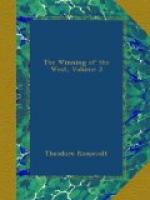The truth was that the American military authorities fell into much the same series of errors as their predecessors, the British, untaught by the dreary and mortifying experience of the latter in fighting these forest foes. The War Department at Washington, and the Federal generals who first came to the Northwest, did not seem able to realize the formidable character of the Indian armies, and were certainly unable to teach their own troops how to fight them. Harmar and St. Clair were both fair officers, and in open country were able to acquit themselves respectably in the face of civilized foes. But they did not have the peculiar genius necessary to the successful Indian fighter, and they never learned how to carry on a campaign in the woods.
They had the justifiable distrust of the militia felt by all the officers of the Continental Army. In the long campaigns waged against Howe, Clinton, and Cornwallis they had learned the immense superiority of the Continental troops to the local militia. They knew that the Revolution would have failed had it not been for the continental troops. They knew also, by the bitter experience common to all officers who had been through the war, that, though the militia might on occasion do well, yet they could never be trusted; they were certain to desert or grow sulky and mutinous if exposed to the fatigue and hardship of a long campaign, while in a pitched battle in the open they never fought as stubbornly as the regulars, and often would not fight at all.
The Regulars in Indian Warfare.
All this was true; yet the officers of the regular army failed to understand that it did not imply the capacity of the regular troops to fight savages on their own ground. They showed little real comprehension of the extraordinary difficulty of such warfare against such foes, and of the reasons which made it so hazardous. They could not help assigning other causes than the real ones for every defeat and failure. They attributed each in turn to the effects of ambuscade or surprise, instead of realizing that in each the prime factor was the formidable fighting power of the individual Indian warrior, when in the thick forest which was to him a home, and when acting under that species of wilderness discipline which was so effective for a single crisis in his peculiar warfare. The Indian has rarely shown any marked excellence as a fighter in mass in the open; though of course there have been one or two brilliant exceptions. At times in our wars we have tried the experiment of drilling bodies of Indians as if they were whites, and using them in the ordinary way in battle. Under such conditions, as a rule, they have shown themselves inferior to the white troops against whom they were pitted. In the same way they failed to show themselves a match for the white hunters of the great plains when on equal terms. But their marvellous faculty for taking advantage of cover, and for fighting in concert when under cover, has always made the warlike tribes foes to be dreaded beyond all others when in the woods, or among wild broken mountains.




